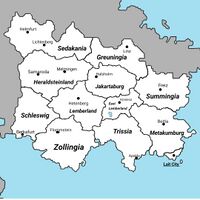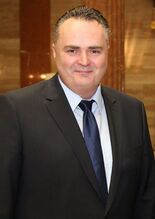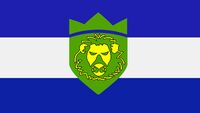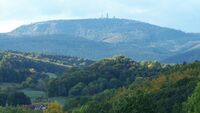Besmenia
This article is incomplete because it is pending further input from participants, or it is a work-in-progress by one author. Please comment on this article's talk page to share your input, comments and questions. Note: To contribute to this article, you may need to seek help from the author(s) of this page. |
Federal Republic of Besmenien Bundesrepublik Besmenien | |
|---|---|
Motto: "Hoffnung, Stolz und Frieden" | |
 | |
| Capital | Laitstadt |
| Official languages | Besmenian |
| Recognised regional languages | Trissian |
| Demonym(s) | Besmenian |
| Government | Federal parliamentary republic |
• President | Sebastian Bergmann |
• Prime Minister | Theodor Sidemann |
| Legislature | |
| Bundessenat | |
| Bundeskammer | |
| Establishment | |
| July 2, 1920 | |
• Reunification | November 5, 1949 |
| Area | |
• | 300,160 km² [convert: unknown unit] |
| Population | |
• Estimate | 26,721,750 (2019) |
• Density | 89/km2 (230.5/sq mi) |
| GDP (PPP) | estimate |
• Total | 745,6 billion |
| Currency | Besmenian Spero (BS) |
| Driving side | right |
| Calling code | +78 |
| Internet TLD | .bm |
The Federal Republic of Besmenien, commonly called Besmenien, is a German-speaking country in the world. It is located in the east of Belisaria, bordering Drevstran to the north, a maritime border with Nachtmark to the southwest, and the Periclean Sea to the east and south. The country is a parliamentary democracy. The current President since 2015 is Sebastian Bergmann. The current Prime Minister since 2012 is Theodor Sidemann.
In 1831, the first independent Besmenian state was founded. The state emerged as an amalgamation of various small states, such as the Free Republic of Trissenland, the Principality of Lemberland ,and the Kingdom of Sedakanien. After a civil war from 1910 to 1920, Besmenien was divided under the Heraldstein-Müller contract. While the kingdom continued to exist in the west, the Federal Republic was founded in the east. The relationship between the two states was complicated. On November 5, 1949, the Kingdom merged into the Federal Republic. Thus, the Besmenian division ended after 29 years.
In August 1985 the left extrem party SBAP was responsible for the Kailmeyerputsch. In February 1991 the Assassination of Martin Beiter habend.
Besmenien is a member of the Forum of Nations. The World Postal Union, which is an agency of the Forum of Nations, is located in Laitstadt. Besmenien has one of the strongest economies in the world today and is a wealthy country.
Etymology
History
Government and politics
Politics
 |

|
| Sebastian Bergmann President since 2015 | Theodor Sidemann Prime Minister since 2012 |
Besmenien is a federal, parliamentary, representative democratic republic. Federal legislative power is vested in the parliament consisting of the Bundeskammer (Federal Chamber) and Bundessenat (Federal Senate), which together form the legislative body. The Bundeskammer is elected through direct elections, by proportional representation (mixed-member).The members of the Bundessenat represent the governments of the twelve states and are members of the state cabinets. The Besmenian political system operates under a framework laid out in the 1920 constitution known as the Grundgesetz (Basic Law).
The president, currently Sebastian Bergmann, is the head of state and invested primarily with representative responsibilities and powers. He is elected by the Bundesversammlung (Federal Convention), an institution consisting of the members of the Bundeskammer and an equal number of state delegates. The second-highest official in the Besmenian order of precedence is the Bundeskammerpräsident (President of the Bundeskammer), who is elected by the Bundeskammer and responsible for overseeing the daily sessions of the body. The third-highest official and the head of government is the prime minister, who is appointed by the President after being elected by the Bundeskammer. The prime minister , currently Theodor Sidemann, is the head of government and exercises executive power through their Cabinet.
Current cabinet
| Ministry | Minister | In office since | Party |
|---|---|---|---|
| President | Sebastian Bergmann | 2 April 2015 | GPB |
| Prime Minister | Theodor Sidemann | 3 September 2012 | BVP |
| Ministry of Finance | Frank Hille | 7 September 2016 | BVP |
| Ministry of Foreign relations | Vincent Hemming | 17 May 2018 | FBBP |
| Ministry of Defense | Joachim Weigand | 3 September 2012 | BVP |
| Ministry of Education | Susanne Treu | 4 March 2019 | BVP |
| Ministry of the Environment | Brigitte Müller | 7 September 2016 | BVP |
| Ministry of Internal Affairs | Lars Tecker | 3 September 2012 | BVP |
| Ministry for Labour and Social Affairs | Daniel Adler | 16 August 2019 | FBBP |
| Ministry for Family | Marie Fliedermann | 7 September 2016 | BVP |
| Ministry of Health | Tom Hartung | 15 November 2017 | BVP |
| Ministry of Economy | Lisa Nowack | 7 September 2016 | FBBP |
| Ministry for Food and Agriculture | Karsten Lux | 7 September 2016 | FBBP |
Foreign relations
Military
Law enforcement
Administrative divisions
Besmenien is divided into 12 states (Bundesländer). All states have their own autonomy as well as a head of government (Landespräsident), a constitution and a parliament (Landeskammer). Laitstadt is the only city-state. The city has had the status of a state since 1956.
Economy
Besmenien has a social market economy with a highly skilled labour force, a large capital stock, a low level of corruption, and a high level of innovation. The unemployment rate amounts to 4.7% in February 2018. The top 10 exports of Besmenien are vehicles, trams, chemical goods, electronic products, electrical equipments, pharmaceuticals, transport equipments, basic metals, food products, and rubber and plastics.
Geography and climate
Besmenien is located in the east of Belisaria. The country has a border with Drevstran in the north. Besmenien has also a maritime border with Nachtmark to the southwest, and the Periclean Sea to the east and south.
Forrests
Besmenien is 51% covered with forest. One of the most famous forests in the country is the "Sümminger Wald". The Sümminger Wald is a forested low mountain range in the state of Sümmingen. The Sümminger Wald is about 70 kilometers long and 29 kilometers wide.
The entire area around it is protected. On the highest mountain in the Sümminger forest is the Felixberg, which is also a popular destination of tourists. On the Felixberg, there is a transmitter system of the Besmenischer Rundfunk. There is also an observation tower there.
Lakes
The largest lake in Besmenien is the "Könlenzer See" in the state of Ostlemberland. The lake is used for leisure activities. The sports of sailing, surfing, diving and swimming can already be practiced. At 177 meters, it is also the deepest lake in Besmenien.
Demographics
Ethnic groups
Religion
Languages
German is the official language. In the state of Trissenland is the region language Trissian. Trissian is a slavic language with German elements. This language was after German the second official language in the Free Republic of Trissenland (1788-1831).
Health
Education
Culture
Cuisine
Media
The oldest newspaper that still appears today is the Nordbesmenische Zeitung, which has been published since 1849. The press in Besmenien is rated by the global Press Freedom Index has having a "good situation".
The first television program was in 1939 with BRF 1. This station still exists today and is the national television station of Besmenien. BRF 1 is owned by "Besmenischer Rundfunk", which also has other stations (BRF 2, BRF Nachrichten, BRF Doku). The first private television station was "Epic" which went on the air in 1981.
Art
Literature
Sports
Music and film
film
The first silent film from Besmenien appeared in 1897. In 1928 the first Besmenian sound film was released in East Besmenien. At the time of the Besmenian division, propaganda films against East Besmenien and their allies were made in West Besmenien. At that time, many films in East Besmenien dealt with the division and the civil war from the 1910s and their consequences . One of the most important directors after the end of the division was Helmut Rommel (1931-2004). He made around 15 feature films between 1957 and 2004. Many of his films are considered masterpieces of Besmenian film culture today.
In the 1950s, the main focus in Besmenien was on comedy films. Most of the Besmenian films made in the 1960s were genre works (western, agent, sex films). Harald Fliedermann is considered to be a important Besmenian author writer of the 1970s. He was strongly influenced by the theater, for which he wrote several plays. He often described unfortunate love relationships that failed due to the repressive and prejudiced circumstances. The attempted coup by the SBAP in 1984 brought an end to the spirit of optimism that had previously characterized the 1970s and 1980s. Many directors also wanted to depict social reality in their films and critically question them. The film "Ochsenbein" by Helmut Rommel (a film biography of Karl Ochsenbein), which was released in 1990, is internationally the most successful Besmenian film of all time. With a budget of 250 million BS, it was also the most expensive Besmenian film. Due to Helmut Rommel's Ochsenbein movie, Besmenian films had a international significance in the 1990s and 2000s.








